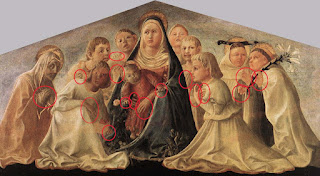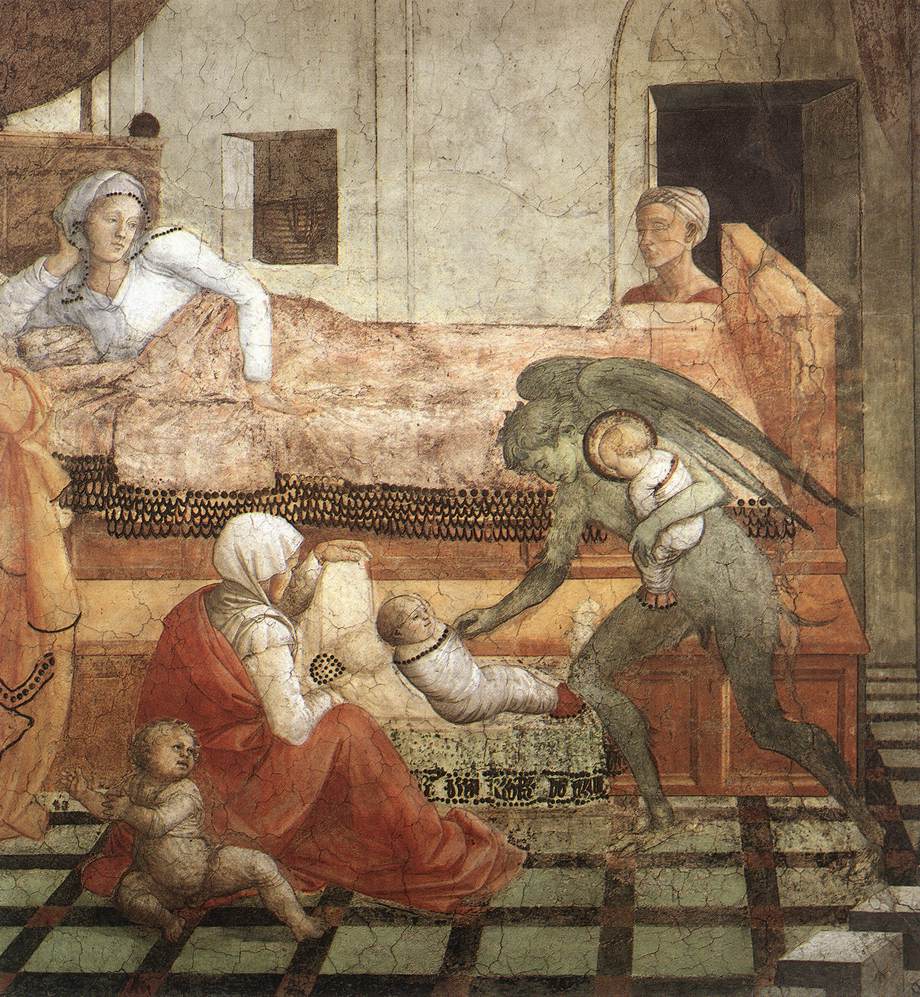Monday, November 9th, 2009
Fra Filippo Lippi’s "Handy" Work
Vasari writes that Fra Filippo Lippi made a conscious decision to stop including a lot of hands in his paintings. Apparently, Lippi had been criticized for including too many hands in his compositions, and someone advised him to be aware of that fact.1 Lippi received this sound advice around 1445, and Vasari writes that in later paintings Lippi “covered [the hands] up with draperies or some other invention in order to avoid such criticism.”2
In some ways, you really can see a switch from the “hand” to “hand-free” Lippi. (Okay, in truth, his later paintings aren’t “hand-free,” but often there aren’t as many hands.) Here are some earlier, “handy” paintings:
 St. Fredianus Diverts the River Serchio, c. 1438
St. Fredianus Diverts the River Serchio, c. 1438There are way too many hands in the group on the right. And look at the man who is standing on the left side of that group – his hands are awkwardly included in the composition to the point of distraction. It almost looks like that man is going to box the ears of the pious man who is kneeling down.
 Madonna of Humility (Trivulzio Madonna), c. 1430
Madonna of Humility (Trivulzio Madonna), c. 1430
(with red circles added – click here to see a reproduction without circles)
I think this painting is pretty ugly, and the plethora of hands doesn’t help the composition one bit. I circled sixteen different hands. Granted, there are a lot of figures in this painting, but sixteen hands seems a little extreme and unnecessary. Hands pop out in some of the strangest places, too. Check out some of the hands on the left-side of the Virgin.
 Detail of Disputation in the Synagogue, 1452-65
Detail of Disputation in the Synagogue, 1452-65Notice how Lippi covered up the figure on the left’s hands with drapery? Smart move. There aren’t any miscellaneous fingers or palms sticking out anywhere, either, which is an improvement.
 Detail of St. Stephen is Born and Replaced with Another Child, 1452-65
Detail of St. Stephen is Born and Replaced with Another Child, 1452-65Lippi toned down the hands a bit in here – Stephen’s mother covers up one hand with her head, and the seated woman covers up a hand with her knee (although I think her other hand is awkward in its position and placement). And you don’t even see the hands of the figure behind the bed. I think, though, that the woman on the left’s hand is poking out from behind her cloak – it’s a little awkward since its the only part of the woman that we can see, but hey, this is an improvement for Lippi.
1 Giorgio Vasari, The Lives of the Artists, translation by Julia Conway Bondanella and Peter Bondanella (London: Oxford University Press, 1991), 194.
2 Ibid.
Mainly I imagine somebody saying to tiny boy artist Filippo "my, you certainly are GOOD at drawing HANDS!"…and thus a monster was born…
It's kind of interesting how criticism sticks with us forever. I wonder if he was always self-conscious about ALL things concerning hands for the rest of his life — something like if he even hated the sight of his own or something.
Though … I've got to say that "Madonna of Humility" is WAY out of control in terms of the number of hands. Whoever gave him the criticism really did him a favor.
Very interesting…it is very distracting with numerous hands popping out everywhere. One of my main points in my Kathe Kollwitz thesis was that idea that hands are just as or sometimes more expressive than faces. With that many hands in his compositions, it's just too busy with too much to look at.
The hands are wayyyyyy out of control in Lippi's early paintings. It's interesting that hands make so much of a visual impact, so if there's too many, the painting looks too busy.
I wonder if Lippi got out of control with hands because they're difficult to draw–so he looked at them as a badge of skill and stuffed his paintings full of 'em.